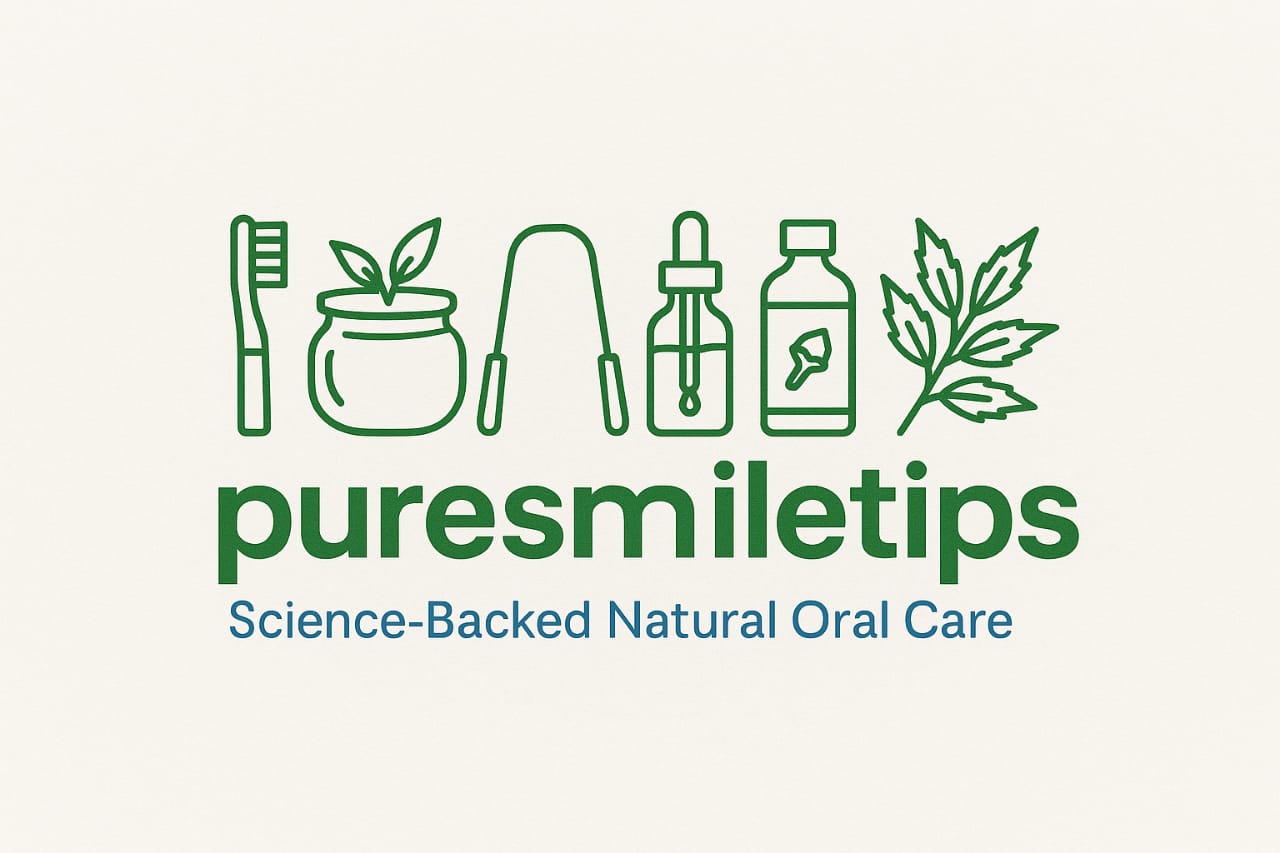Medical Disclaimer: When it comes to medical advice or any sort of treatment, you really should consult a qualified dentist. This advice is for temporary relief. When tooth pain starts showing up again and again, you really ought to have a dentist take a look at it.
Please don’t ignore professional care based on what you read here.
Are you desperately searching for effective home remedies for instant cavity pain relief? or even emergency tooth pain relief at home? The pain from a tooth can take control of your entire existence. The pain creates a total focus on itself because it produces either a sharp, intense pain or a continuous, dull sensation.
This blocks out all other experiences. The situation demands urgent attention for effective solutions. You are after genuine fixes that actually get things done. Time to feel better. The good news is that you can achieve immediate comfort using dentist-approved methods to safely manage the pain until you can see a professional.
Reviewed by: [Dr. Jane Smith, DDS]
This guide cuts through the overwhelm to give you ten proven, actionable strategies and the most effective natural remedies for cavity pain to numb the discomfort at home, quickly and effectively. All our recommendations are backed by dental science and expert advice for your safety.

Let’s get to your relief plan.
The simple kitchen ingredient that acts as a natural antibacterial and pain-soothing rinse.
A powerful numbing agent available at any pharmacy that can temporarily “switch off” the nerve pain.
The correct technique for using a cold compress to reduce inflammation and dull the sensation effectively.
A crucial warning on one common “remedy” you should absolutely avoid, as it can damage your tooth enamel.
The pain from a tooth can take control of your entire existence. The pain creates a total focus on itself because it produces either a sharp, intense pain or a continuous, dull sensation. This blocks out all other experiences. Feel better now.
Continue reading to unlock these ten dentist-approved strategies, including exactly how to numb a toothache at home safely and which remedies provide the fastest relief. Let’s get you feeling better, fast.
Table of Contents
ToggleUnderstanding Cavity Pain: Why It Hurts So Much
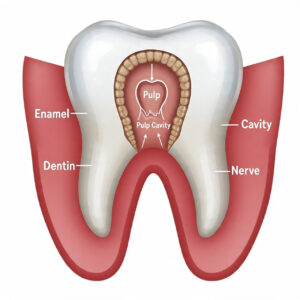
A cavity is a tiny opening in your tooth that forms from tooth decay. A cavity in the early enamel stage often has no pain. A cavity becomes sensitive once it reaches the inner layer of your tooth (dentin). The reason is that the dentin has tiny channels connected directly to the nerve.
A throbbing toothache is a cavity hitting the nerve. Before you can find safe Home Remedies for Instant Cavity Pain Relief, it helps to know it’s the pressure inside causing the pain.
That intense, stabbing pain from a cavity demands immediate action. The remedies in this guide are crucial for managing that crisis. However, real healing doesn’t just hide the pain—it involves addressing the root cause of the decay. While you manage this immediate discomfort, you can also explore how to reverse cavities naturally to strengthen your teeth for the long term.
For Your Safety and Best Results
Important Safety Precautions Before You Begin
This relief is a temporary fix. For lasting peace, your dentist is your best path forward.
This is Temporary Relief: Emphatically, these methods are a bridge to professional dental care, not a replacement. Use these to get through the crisis, but don’t cancel your dental appointment. The underlying issue needs professional care.
Perform a Patch Test: If you’re using any new substance, particularly essential oils like clove or thyme oil, apply a small amount to the skin on your inner forearm first. Test it on your skin and wait 30 minutes. No reaction means it’s safe for your mouth.
Do Not Use Aspirin Directly on the Tooth or Gums: This is a critical warning. Placing aspirin directly on the goo or tooth can beget a chemical burn known as” aspirin burn.” This burns your gums, causing a painful sore. Now you’d have a gum ache and a toothache to deal with.
Always Dilute Potent Ingredients: Never use undiluted essential oils or high-concentration hydrogen peroxide directly in your mouth.
Essential oils must be mixed with a carrier oil (like coconut or olive oil), and hydrogen peroxide should always be adulterated to a 1.5 result (mixing equal corridor of 3 hydrogen peroxide and water).Listen to Your Body: If a treatment doesn’t feel right or makes things worse, stop using it right away. More pain means you should stop.
Home Remedies for Instant Cavity Pain Relief
Now that you understand the crucial safety guidelines, let’s explore the proven home remedies for instant cavity pain relief that can help you safely manage this acute discomfort.
Your Emergency Guide for Severe Toothache Relief
Step 1: Clean the Area. First, carefully floss around the painful area. A bitsy piece of food stuck in the wrong spot can be the main source of the pain.
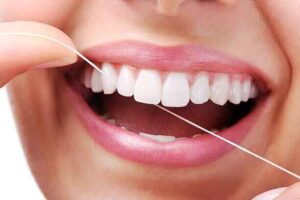
Step 2: Reduce Inflammation Immediately. Wash your mouth with a warm saltwater result for 30- 60 seconds. This is the fastest way to draw out fluid from inflamed tissues and reduce the bacterial cargo causing the pain.

Step 3: Numb the Nerve Directly. Apply a strong numbing gel directly to the pain. Use a cotton ball with diluted clove oil or an over-the-counter anesthetic gel containing Benzocaine directly to the tooth and gum. This provides a direct” switch- off” signal to the irritated whim-whams.

Step 4: Manage Systemic Pain and Swelling. Take an untoward anti- seditious medicine like Ibuprofen if you are suitable. This addresses the deep, pulsating pain from the inside out by reducing the inflammation at its source.
Step 5: Apply External Cold. Place a cold wave compress or ice pack wrapped in a cloth on your impertinence over the painful area for 15 twinkles. This helps ‘turn down the volume’ on swelling and pain by reducing blood flow to the area.
This protocol combines multiple approaches for maximum effect. In the next section, we will break down each of these remedies and more in exhaustive detail.
Unbearable Tooth Pain? What to Do at Home Immediately
If you find yourself in a real crisis because of the pain. Maybe it is the middle of the night or even a weekend when things feel worse. Follow this plan now to take control and find quick relief.
Floss Gently and Thoroughly: Often, excruciating, localized pain can be caused by a food particle—like a tiny piece of meat or popcorn hull—trapped deep between your teeth or wedged into an existing cavity. The pressure from that, plus the swelling right after, can get enough violent now and also. Floss between teeth.
Rinse with Warm Salt Water: This instantly soothes pain and reduces germs. It soothes with warmth and cleans with salt. Swish the result roundly for 30 seconds, icing it gets around the painful tooth, also spear it out. This can help for a bit.
Take an Over the Counter (OTC) Pain Reliever: To fight the pain and the swelling together, an anti-inflammatory like Ibuprofen is your best bet. Can not take NSAIDs? Acetaminophen (Tylenol) can help with the pain rather. Use as directed on the label.
Apply a Cold Compress: That pounding sensation is caused by inflammation. 15 minutes with ice. This reduces swelling and numbs the nerve. Remember to use a cloth as a barrier.
Try these ten remedies for lasting relief.
How to Stop Tooth Nerve Pain Instantly: 10 Dentist-Approved Remedies
Here is your complete toolkit for combating cavity pain. Each remedy includes the “why” it works from a scientific and dental perspective and the “how” to do it correctly for maximum effect and safety.
1. The Saltwater Rinse: The Most Accessible Home Remedy for Cavity Pain in Teeth
A saltwater rinse is a classic, globally recognized dental recommendation for a reason. A natural disinfectant that’s both gentle and effective.
Why it Works: A saltwater rinse works like a two-step cleanup crew. First, it soaks up the inflammation and swelling from your gums. It controls bacteria.
To calm mouth inflammation, try a saltwater rinse – it’s ADA-recommended.How to Use: Add half a teaspoon of salt to a warm glass of water and give it a good stir. Stir until clear. Swish thoroughly for 30 seconds, targeting the painful tooth. Spit it out. For best results, repeat every 2-3 hours or after you eat.
2. Targeted Numbing with Clove Oil

Dentists now verify what people have known for centuries: clove oil effectively relieves toothaches.
Why it Works: Clove oil numbs the pain by naturally anesthetizing the nerve. This makes clove oil a highly effective answer for how to stop tooth nerve pain at home. A 2022 systematic review published in PMC confirmed that eugenol-based preparations are as effective as conventional topical anesthetics like benzocaine for managing dental pain.
How to Use: Safety first: always dilute. Safety first: always dilute. Dilute clove oil with carrier oil. Apply with cotton ball for 10-15 minutes. Reuse every few hours as needed.
3. Harnessing a Cold Compress the Right Way
You might be using your cold compress wrong for toothaches.
Why it Works: The application of cold causes vasoconstriction—the narrowing of blood vessels. This helps ‘turn down the volume’ on swelling and pain.
How to Use: Do not apply ice directly to the skin, as this can cause frostbite. Keep this up until you get some relief.
4. Using Over-the-Counter Anesthetic Gels for Fast Relief
These gels are made for mouth pain and work right where you need them.
Why it Works: OTC oral gels like Anbesol or Orajel contain active ingredients such as Benzocaine. Benzocaine functions by soothing the nerve signals. That keeps the pain from making it through. It blocks the pain right away.
How to Use: First, dry the area around the painful tooth with a clean gauze pad or tissue. Make sure you stick to the product directions pretty closely. You usually put on just a pea-sized dab right onto the sore tooth and gum area. Use a cotton swab for that, or your clean finger if you prefer. Stick to no more than the suggested uses each day. That is often around four times. And do not keep using it past seven days. Get advice straight from a dentist first if you need to go longer.
5. The Power of Anti-Inflammatory Pain Relievers
Use pain relief you can buy at the store.
Why it Works: Nonsteroidal anti-inflammatory drugs (NSAIDs) like Ibuprofen (Advil, Motrin) or Naproxen (Aleve) work by inhibiting the body’s production of compounds called prostaglandins. Swelling? Ibuprofen. Just pain? Acetaminophen.
By reducing their levels, these medications address the root cause of the throbbing sensation. Acetaminophen (Tylenol) can relieve pain and fever but does not have significant anti-inflammatory properties.
How to Use: Take the medication exactly as directed on the package, with a full glass of water. For dental pain, Ibuprofen is often the preferred choice due to its strong anti-inflammatory effect.
This is a critical point: In case you are carrying a baby or if you have a condition of the kidneys or stomach, kindly see your doctor before using this.
6. Hydrogen Peroxide Rinse for Cleaning and Soothing
A diluted hydrogen peroxide rinse can help kill bacteria, remove debris, and provide relief by reducing the microbial load in the cavity.
Why it Works: Hydrogen peroxide is a potent oxidizing agent. Their bubbling or effervescent action is able to somewhat mechanically loosen food particles and dead tissue from the cavity. What is most important, though, is that it releases oxygen, thereby making the place unsuitable for anaerobic bacteria that thrive in cavities and cause infection and pain. A potent antiseptic, it is.
How to Use: This step is crucial for safety. It is a must that you dilute it with water in which the quantity is equal to that of the original liquid. Next, wash your mouth with the diluted solution for 30 seconds, spit, and then rinse with plain water. Do you want to risk it? Then, the use of it should not be more than once a day.
7. Garlic: A Potent Natural Antibacterial
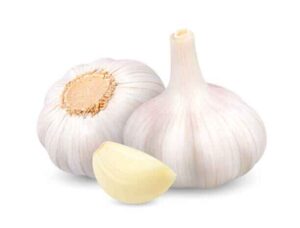
Garlic is more than a culinary staple; it’s a powerful medicinal plant with a long history of use for infections.
Why it Works: When a clove of garlic is crushed or chopped, an enzyme called alliinase converts the compound alliin into allicin. Allicin is a sulfur-containing compound with broad-spectrum antimicrobial and anti-inflammatory properties.
It can help fight the specific bacteria in the cavity, reducing both the infection and the resulting pain. In fact, garlic is considered one of the powerful superfoods for healthy teeth and gums that can support your overall oral health beyond just pain relief.
How to Use: Crush a fresh garlic clove with the flat side of a knife or a garlic press to activate the allicin. Mix this crushed garlic with a tiny pinch of salt to enhance its antibacterial effect and help draw out moisture. Apply this paste directly into the cavity using a cotton swab or your clean finger.
Alternatively, you can chew a fresh clove of garlic slowly on the affected side. Be prepared for the strong, persistent taste and odor.
8. Oil Pulling with Coconut Oil to Reduce Bacteria
An ancient Ayurvedic practice, oil pulling has gained modern popularity for its oral health benefits, primarily by reducing harmful bacteria.
Why it Works: Coconut oil is rich in lauric acid, a medium-chain fatty acid known for its potent antimicrobial and anti-inflammatory effects. The theory is that swishing the oil for an extended period “pulls” bacteria and plaque from the surfaces of the teeth and gums, which are then suspended in the oil and removed from the mouth when you spit it out.
This overall reduction in oral bacteria can help soothe the irritated tissues around the painful cavity.
How to Use: Upon waking, before eating or drinking, take one tablespoon of virgin, cold-pressed coconut oil. Swish it around your mouth, pushing and pulling it through your teeth. Do this gently for 15-20 minutes. The oil will mix with your saliva and become thinner.
Do not swallow the oil, as it contains bacteria and toxins. Spit it into a trash can (not the sink, as it can solidify and clog pipes), then rinse your mouth thoroughly with warm water and brush your teeth as usual. For a complete guide to oil pulling with all its benefits and proper technique, check out our detailed article here.
9. Guava Leaf Tea: A Natural Anti-Inflammatory Rinse
Fresh or dried guava leaves are a traditional remedy that has been validated by scientific research for their oral health benefits.
Why it Works: Guava leaves are rich in flavonoids, particularly quercetin, and other compounds that have demonstrated strong anti-inflammatory, antimicrobial, and analgesic (pain-relieving) properties. A rinse made from guava leaves can help reduce gum inflammation and fight the bacteria causing the pain.
How to Use: If you have fresh guava leaves, wash 4-5 leaves thoroughly. You can chew them gently until the juice reaches the painful tooth. For a rinse, boil a handful of fresh or dried guava leaves in a cup of water for 5-10 minutes.
Allow the solution to cool to a warm temperature, strain it, and add a pinch of salt. Use this as a mouthwash, swishing for 30 seconds, 2-3 times a day.
10. Elevating Your Head to Reduce Night-Time Throbbing
This is a simple, zero-cost physiological “life hack” that can provide genuine relief, especially when trying to sleep.
Why it Works: When you lie flat, the blood pressure in your head and jaws increases slightly due to gravity. This increased blood flow and pressure can exacerbate the pounding, throbbing sensation in an already inflamed tooth nerve.
By elevating your head above the level of your heart, you help drain some of the excess fluid and reduce the pressure in the blood vessels surrounding the tooth, thereby lessening the pain.
How to Use: Use an extra pillow or two to prop your head up while you sleep. Alternatively, you can use a wedge pillow. The goal is to keep your head elevated throughout the night. Combine this with other remedies from the night-time guide for the best chance of uninterrupted sleep.
Now that you have a full arsenal of remedies, let’s address a specific and common scenario: dealing with pain that strikes at night, when it can feel most isolating and intense.
How to Get Rid of a Toothache Fast at Night: A Dentist-Approved Emergency Guide
Night-time tooth pain often feels magnified because there are fewer distractions, and the quiet can make you hyper-aware of the discomfort. Furthermore, the act of lying down, as explained, increases blood pressure to the head. Here is a dedicated, step-by-step night-time action plan to help you get the rest you desperately need:
- Start with a Pre-Bed “Clean and Numb” Routine: About an hour before bed, begin your regimen. First, use the saltwater or diluted hydrogen peroxide rinse to thoroughly clean your mouth and reduce bacteria.
Then, apply your chosen numbing agent—either the diluted clove oil mixture or an OTC anesthetic gel—directly to the cavity and surrounding gum. This gives it time to take full effect before you lie down.
2. Take Pain Medication Strategically: If you are due for another dose of an OTC pain reliever, take it about an hour before you plan to sleep. This allows the medication to reach its peak concentration in your bloodstream just as you are trying to fall asleep.
3. Elevate Your Head Proactively: Don’t wait for the pain to start. As you get into bed, make sure you are using two or three pillows to keep your head significantly elevated. This is a preventative measure to minimize pressure buildup from the start.
4. Keep a Cold Compress Handy: Have an ice pack wrapped in a cloth ready on your nightstand. If you wake up in the middle of the night with a throbbing pain, apply the compress to your cheek for 15 minutes. The combination of cold and elevation can often calm the nerve enough for you to fall back asleep.
5. Create a Distraction: If pain and anxiety are keeping you awake, try putting on a calming podcast, an audiobook, or soft, instrumental music at a low volume. Focusing on something other than the pain can sometimes be enough to help your brain disengage and allow sleep to come.
Following this dedicated protocol can make the difference between a sleepless night of agony and getting the restorative rest your body needs. Next, we’ll look more closely at how these remedies address the physical problem—the hole in your tooth.
Hole in Tooth Pain Relief: Addressing the Source of the Problem
The visible “hole” is the cavity itself—the epicenter of the problem. When pain emanates from a visible pit or opening, it means the nerve deep within the tooth is exposed to stimuli from the oral environment. The remedies above work by creating a barrier, reducing the bacterial population inside the hole, and calming the inflamed nerve.
For example, applying a clove oil-soaked cotton ball directly into the hole can provide deep, targeted relief by delivering the anesthetic and antibacterial properties of eugenol right to the source of the infection.
Similarly, a saltwater or hydrogen peroxide rinse helps clean out the cavity, flushing away food particles and bacteria that can fester and exacerbate the pain and inflammation. Think of the cavity as a wound; these remedies are about keeping that wound clean and numbed until a professional can permanently seal it.
While it’s tempting to try anything for relief, especially when in distress, some popular “remedies” are not just ineffective—they are actively dangerous. Let’s expose the one you must absolutely avoid.
The “Quick Fix” You Must Absolutely Avoid
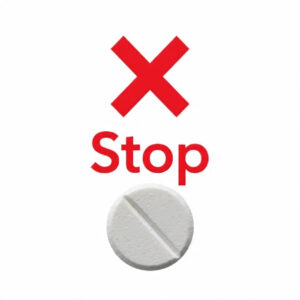
You may have read online or heard from well-meaning friends about using aspirin directly on your tooth or gum. This is not only ineffective for topical pain relief but is one of the most damaging things you can do.
Why You Must Avoid It: Aspirin (acetylsalicylic acid) is designed to work systemically, meaning it must be swallowed and absorbed into your bloodstream to reduce pain and inflammation throughout your body. When placed directly against your moist gum tissue, it does not numb the pain.
Instead, because it is a powerful acid, it causes a localized chemical burn. This burn leads to a condition aptly named “aspirin burn,” which results in painful, white, ulcerated, and necrotic (dead tissue) lesions on your gums or the inside of your cheek. This adds a new, entirely preventable, and often severe source of pain and tissue damage to your existing problem, complicating any future dental treatment.
Always remember that all the remedies listed earlier are temporary measures. Knowing precisely when to stop self-managing and seek professional help is critical for your long-term oral and overall health.
When Home Remedies Aren’t Enough: Time to See a Dentist
Home management is a short-term strategy for temporary pain control. You must see a dentist as soon as possible if you experience any of the following “red flag” symptoms, which indicate that the problem is severe or spreading:
The pain lasts longer than 1-2 days despite using home remedies.
You develop a fever, which is a clear sign that your body is fighting a spreading infection.
You have difficulty breathing or swallowing. This is a medical emergency, as it can indicate a severe infection that is compromising your airway. Go to an emergency room immediately.
Your face, cheek, or jaw becomes significantly swollen. This indicates a serious dental abscess or cellulitis.
You see a pimple-like bump on your gum near the painful tooth (a gum boil or abscess) or notice a foul taste in your mouth, both signs of pus drainage from an infection.
A dentist will provide a permanent solution. For a simple cavity, this is a filling. If the decay has reached the pulp, a root canal treatment is necessary to remove the infected nerve tissue. In some cases, if the tooth cannot be saved, an extraction may be required.
These procedures are the only way to permanently eliminate the source of the pain and prevent life-threatening complications.
To wrap up, let’s answer some of the most common and specific questions people have about cavity pain in a dedicated FAQ section.
Your Frequently Asked Questions on Stopping Cavity Pain
1. What is the best natural way to stop tooth pain?
For immediate, natural relief, clove oil is widely regarded as the most effective option. Its active component, eugenol, is a natural anesthetic and antiseptic that can numb the nerve and fight infection directly. For this reason, many dentists consider it the best natural alternative.
A close second is a concentrated saltwater rinse, which reduces inflammation and cleanses the area effectively. Ultimately, the ‘best’ method is the one that works for your specific pain, but starting with clove oil provides the strongest natural numbing effect available without a prescription.
2. What naturally kills tooth pain?
The most effective natural substances that kill tooth pain are clove oil, due to its eugenol content which acts as a natural anesthetic, and garlic, which contains allicin, a powerful antibacterial. A saltwater rinse is also a highly effective natural method to soothe inflammation and clean the area, providing significant relief.
3. What kills tooth pain instantly at home?
For the fastest possible relief, you need to directly target the nerve and inflammation. The most effective dentist-approved methods for instant action are, in order:
Over-the-Counter Anesthetic Gels: Products containing Benzocaine (like Orajel) can numb the nerve endings at the surface, providing relief within 1-2 minutes.
A Targeted Cold Compress: Applying a cold pack to your cheek for 15 minutes constricts blood vessels, reducing swelling and throbbing pain almost immediately.
Diluted Clove Oil: Its active component, eugenol, is a natural anesthetic. Applying it with a cotton ball can ‘switch off’ pain signals quickly.
Crucial Note: While these provide instant relief, they are temporary. The underlying cavity will continue to worsen without professional dental treatment.
4. How to stop pain from a cavity?
The fastest and most effective way is to combine methods for a multi-pronged attack. Start with a saltwater rinse to mechanically clean the area and reduce surface bacteria. Then, immediately follow up by applying a targeted numbing agent like diluted clove oil or an OTC anesthetic gel directly to the cavity and surrounding gum to shut down the pain signals at the source.
For deeper, throbbing pain, taking an anti-inflammatory pain reliever like Ibuprofen can address the systemic inflammation and swelling that is causing the pressure.
5. What are the best natural remedies for cavity pain?
The most effective and dentist-approved natural remedies for cavity pain include a warm saltwater rinse to reduce inflammation, diluted clove oil for its natural numbing properties (eugenol), and garlic for its powerful antibacterial compound (allicin). These provide relief by targeting the source of the pain—bacteria and nerve inflammation.
6. What naturally kills tooth pain?
The most effective natural substances for killing tooth pain are those with proven analgesic and antimicrobial properties. Clove oil is the champion here, thanks to its eugenol content which acts as a natural anesthetic.
Garlic is a powerful runner-up due to its allicin, a potent antibacterial that fights the infection at the root of the pain. Additionally, a saltwater rinse is a natural and highly effective way to soothe inflammation and clean the area, providing significant relief.
7. What is the 3-3-3 method for toothache?
While not a substitute for professional care, the 3-3-3 method is a popular coping technique for managing swelling and discomfort. It involves three simple steps: apply a cold compress to the outside of your cheek for 3 minutes, ensuring it’s held about 3 inches from the actual jaw joint to avoid over-cooling nerves, and repeat this process every 3 hours as needed.
It’s crucial to remember this is a first-aid measure to manage symptoms; it does not treat the underlying cavity or infection.
8. How to relieve tooth pain while pregnant?
Safety for both mother and baby is the absolute priority during pregnancy. The safest, most conservative dentist-approved methods are a gentle saltwater rinse or a cold compress applied to the cheek. These are topical and involve no systemic absorption.
It is absolutely essential to consult your dentist and obstetrician immediately before considering any other remedies. They must approve the use of any essential oils, OTC medications (like Acetaminophen), or antibiotics to ensure they are safe for your specific stage of pregnancy. The American Pregnancy Association provides further guidance on managing dental health during this special time.
Your Final Checklist for Instant Cavity Pain Relief
Now that you know exactly how to get rid of dental pain at home, here is a quick-reference checklist to make your action plan simple and executable.
For Immediate Crisis: Floss gently around the painful tooth, then rinse with warm salt water.
For Soothing Relief for Tooth Nerve Pain: Use a warm saltwater rinse or a guava leaf tea rinse to gently calm inflamed tooth nerves and cleanse the area.
For Fast, Targeted Numbing: Apply a diluted clove oil cotton ball or OTC numbing gel directly to the cavity.
For Swelling & Throbbing: Use a cold compress on your cheek in 15-minute on/off intervals.
For Systemic Pain and Inflammation: Take an OTC anti-inflammatory like Ibuprofen, following package directions and considering personal health conditions.
For Deep Cleaning: Use a diluted hydrogen peroxide rinse (once daily) or oil pulling with coconut oil.
For Night-Time Pain: Elevate your head with extra pillows and follow the dedicated night-time guide.
For Ongoing Care: Continue rinsing with salt water 2-3 times a day to maintain cleanliness.
AVOID: Placing aspirin directly on the gum or tooth at all costs.
CRITICAL STEP: Book an appointment with your dentist as soon as possible. This is the only way to permanently resolve the cavity, eliminate the infection, and prevent future pain and more extensive damage.
You now have the knowledge, the tools, and a clear, step-by-step plan to take control of your cavity pain. Use these ten strategies wisely, prioritize your safety with every step, and take that final, crucial action of scheduling your dental visit today. Your path to lasting relief starts now.
